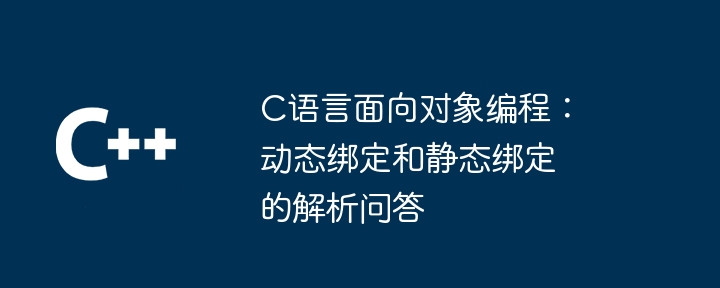动态绑定在运行时根据对象的实际类型解析方法调用,而静态绑定在编译时根据声明类型解析方法调用。

C 语言面向对象编程:动态绑定和静态绑定的解析问答
简介:
动态绑定和静态绑定是面向对象编程中的两个重要概念。它们决定了在运行时如何解析对象方法的调用。
立即学习“C语言免费学习笔记(深入)”;
动态绑定
在动态绑定中,方法的调用在运行时根据对象的实际类型来解析。这意味着,即使在编译时无法确定对象的确切类型,也可以在运行时调用正确的方法。
代码示例:
#include <stdio.h>
typedef struct Shape {
void (*draw)(struct Shape*);
} Shape;
void drawSquare(struct Shape* s) {
printf("Drawing a square.\n");
}
void drawCircle(struct Shape* s) {
printf("Drawing a circle.\n");
}
int main() {
struct Shape square = {drawSquare};
struct Shape circle = {drawCircle};
square.draw(&square); // 输出:Drawing a square.
circle.draw(&circle); // 输出:Drawing a circle.
return 0;
}静态绑定
在静态绑定中,方法的调用在编译时根据对象的声明类型来解析。这意味着,在编译时就必须确定对象的确切类型,并且无法在运行时根据实际类型调用不同的方法。
代码示例:
#include <stdio.h>
class Shape {
public:
virtual void draw() {
printf("Drawing a shape.\n");
}
};
class Square : public Shape {
public:
void draw() {
printf("Drawing a square.\n");
}
};
class Circle : public Shape {
public:
void draw() {
printf("Drawing a circle.\n");
}
};
int main() {
Shape shape;
Square square;
Circle circle;
shape.draw(); // 输出:Drawing a shape.
square.draw(); // 输出:Drawing a square.
circle.draw(); // 输出:Drawing a circle.
return 0;
}区别
主要区别在于,动态绑定允许在运行时调用根据实际类型解析的方法,而静态绑定仅允许在编译时解析的方法。
使用场景
动态绑定通常用于需要灵活性和扩展性的情况下,例如插件系统或框架。静态绑定通常用于需要速度和确定性的情况下,例如系统级编程。
以上就是C语言面向对象编程:动态绑定和静态绑定的解析问答的详细内容,更多请关注php中文网其它相关文章!

每个人都需要一台速度更快、更稳定的 PC。随着时间的推移,垃圾文件、旧注册表数据和不必要的后台进程会占用资源并降低性能。幸运的是,许多工具可以让 Windows 保持平稳运行。




Copyright 2014-2025 https://www.php.cn/ All Rights Reserved | php.cn | 湘ICP备2023035733号